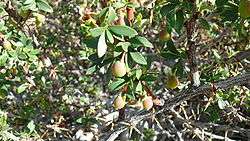Berberis microphylla
| Berberis microphylla | |
|---|---|
 | |
| Calafate (Berberis microphylla) | |
| Scientific classification | |
| Kingdom: | Plantae |
| (unranked): | Angiosperms |
| (unranked): | Eudicots |
| Order: | Ranunculales |
| Family: | Berberidaceae |
| Genus: | Berberis |
| Species: | B. microphylla |
| Binomial name | |
| Berberis microphylla G. Forst. 1789 | |
| Synonyms[1] | |
| |

Berberis microphylla, common name Box-leaved Barberry[2] and Magellan Barberry,[3] in Spanish calafate and michay and other names,[4] is an evergreen shrub, with simple, shiny box-like leaves. The Calafate is native to southern Argentina and Chile and is a symbol of Patagonia.[5][6][7][8] [9][10]
The bush grows to a height of 1.0 to 1.5 m (3 ft 3 in to 4 ft 11 in). It has many arching branches, each covered in many tripartite spines. The bush has many small yellow flowers in summer. Its edible blue-black berries are harvested for jams, but are eaten fresh too - a legend tells that anyone who eats a Calafate berry will be certain to return to Patagonia.
The Calafate is grown commercially for its fruit, potential medical uses[3] and as a garden plant or bonsai. Its wood is used to make a red dye. The cultivar Berberis microphylla 'Nana' is widely available as a garden shrub, and is also used in commercial plantings as a low spiny hedge to discourage intruders, but it does not fruit.[11]
Berberis microphylla should not be confused with Mahonia microphylla T.S.Ying & GR.Long, native to China.[12]
References
- ↑ The Plant List: A Working List of All Plant Species, retrieved 3 January 2016
- ↑ "BSBI List 2007". Botanical Society of Britain and Ireland. Archived from the original (xls) on 2015-02-25. Retrieved 2014-10-17.
- 1 2 Plants for a Future entry for Berberis buxifolia Lam., retrieved 3 January 2016
- ↑ Berberis microphylla at Flora Chilena (Spanish)
- ↑ Ahrendt, L. W. A. (1961). Berberis and Mahonia. A taxonomic revision. J. Linn. Soc., Bot. 57(369): 1–410.
- ↑ Landrum, L. R. 1999 [2000]. Revision of Berberis (Berberidaceae) in Chile and adjacent southern Argentina. Ann. Missouri Bot. Gard. 86(4): 793–834.
- ↑ Hoffmann, A. (1982). Flora silvestre de Chile zona araucana. Edición 4. Ediciones Fundación Claudio Gay, Santiago, Chile. 258p.
- ↑ Landrum, L. R. (2003). Berberidaceae. En C. Marticorena y R. Rodríguez [eds.], Flora de Chile Vol. 2(2), pp 1–23. Universidad de Concepción, Concepción.
- ↑ Marticorena, C. & M. Quezada. (1985). Catálogo de la Flora Vascular de Chile. Gayana, Bot. 42: 1–157.
- ↑ Zuloaga, F. O. (1997). Catálogo de las plantas vasculares de la Argentina. Monogr. Syst. Bot. Missouri Bot. Gard. 74(1–2): 1–1331.
- ↑ Germplasm Resources Information Network - (GRIN). National Germplasm Resources Laboratory, Beltsville, Maryland. URL: http://www.ars-grin.gov/cgi-bin/npgs/html/taxon.pl?6872 Retrieved on November 17, 2007.
- ↑ Flora of China Vol. 19 Page 778 小叶十大功劳 xiao ye shi da gong lao Mahonia microphylla T. S. Ying & G. R. Long
External links
| Wikimedia Commons has media related to Berberis microphylla. |
| Wikispecies has information related to: Berberis microphylla |